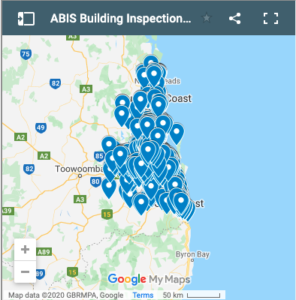Identification on the basis of soldiers can be unreliable – locality, nesting habits, and measurements can assist identification. Their nests may vary from being completely underground, in an old stump or living tree, in sleeper retaining walls, or in domed mounds. Colonies contain a queen, king, soldiers, workers, and reproductives. Soldiers are 3.5 to 6.5mm, have no teeth on their mandibles and pear-shaped yellowish heads which exude a drop of milky fluid from the frontal gland on the top of their head when disturbed.
Coptotermes acinaciformis:
This species does not build mounds, except in its more northern occurrences. They are central site nesters in tree stumps, living trees, under filled-in verandahs where timber has been buried, and in walls. A tree containing a nest may harbour up to a million termites in the single colony. The nest may be located in the root crown of the tree or in the main trunk up to a height of 3 meters where the trunk is hollowed out in the centre and filled with earth-like material “mud-guts” packed above the nest area.
Via underground tunnels or sealed mud leads, buildings within a radius of 50m may be attacked resulting in extensive undetected damage. It is therefore essential that any trees close to buildings be closely monitored for nests. Soil contact is desirable for these termites, but not essential, provided that there are an assured moisture supply and secure habitat. Although their identification can be difficult, they tend to be more aggressive and less easily disturbed than other species. They form large colonies and are much more likely to produce bivouacs.
Coptotermes frenchi:
While the soldiers of this species are smaller (4 to 5.2 mm) than those of Coptotermes acinaciformis, they are found in similar habitats from northern Queensland to South Australia. They are also a central-site nester in the root crown and lower trunk of living trees, and make subterranean tunnels in soil and earthen leads over surfaces. UnlikeCoptotermes acinaciformis, Coptotermes frenchi is very timid and easily disturbed. They form large colonies but rarely produce bivouacs and mudding in their galleries. Coptotermes frenchi tends to be a forest pest attacking living trees and is not as destructive as Coptotermes acinaciformis.




